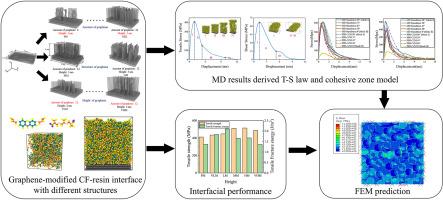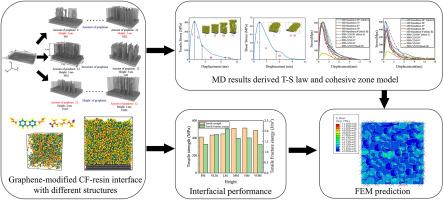石墨烯增强纤维-树脂界面的多尺度分析:结构参数对力学性能的影响
IF 4.5
2区 化学
Q2 POLYMER SCIENCE
引用次数: 0
摘要
碳纤维与树脂基体之间的界面性能对复合材料的力学性能起着至关重要的作用。虽然石墨烯改性的研究已经广泛,但仍需要一个多尺度的框架来分析结构参数如何控制界面力学性能并影响复合材料的整体力学性能。在本研究中,通过内聚区建模(CZM),建立了一个结合分子动力学(MD)和有限元建模(FEM)的多尺度建模框架,将纳米尺度石墨烯结构与宏观尺度复合材料性能联系起来。通过MD模拟,获得了拉伸、剪切和混合模式破坏下的牵引-分离(T-S)响应。仿真结果表明,石墨烯层的加入通过增加纤维表面积来增强纤维表面与树脂基体的相互作用。然而,过高的石墨烯高度或密度会导致界面力学性能降低。此外,均匀的石墨烯层排列显著提高了界面断裂性能。这些原子衍生的见解随后被纳入一个内聚区模型,使FEM能够评估结构参数如何影响宏观力学性能。结果表明,界面力学性能的改善通过宏观载荷传递效率的提高转化为复合材料强度的提高。这项研究提供了对纤维表面修饰如何影响复合材料性能的基本理解,并建立了一个通用的计算框架,可用于优化先进复合材料中基于纳米材料的界面工程。本文章由计算机程序翻译,如有差异,请以英文原文为准。


Multiscale analysis of graphene-enhanced fiber-resin interfaces: effects of structural parameters on mechanical performance
The interfacial properties between carbon fiber (CF) and resin matrix play a crucial role in determining the mechanical performance of composite materials. While graphene modification is widely studied, there is still a need for a multiscale framework to analyze how the structural parameters govern interfacial mechanical properties and influence the overall mechanical performance of composite. In this study, a multiscale modeling framework integrating molecular dynamics (MD) and finite element modeling (FEM) was developed to link the nanoscale graphene structure to macroscale composite performance through cohesive zone modeling (CZM). Through MD simulations, the traction-separation (T-S) responses under tensile, shear, and mixed-mode failure were obtained. The simulation results reveal that the addition of graphene layers enhances interaction between fiber surface and resin matrix by increasing fiber surface area. However, excessive graphene height or density leads to reduced interfacial mechanical performance. Furthermore, a uniform graphene layer alignment significantly improves interfacial fracture performance. These atomic derived insights were subsequently incorporated into a cohesive zone model, enabling FEM to evaluate how structure parameters impact macroscale mechanical performance. The results show that the improved interfacial mechanical properties translate into improved composite strength by enhancing macroscale load transfer efficiency. This study provides a fundamental understanding of how fiber surface modifications influence composite performance and establishes a versatile computational framework that can be applied to optimize nanomaterial-based interfacial engineering in advanced composite materials.
求助全文
通过发布文献求助,成功后即可免费获取论文全文。
去求助
来源期刊

Polymer
化学-高分子科学
CiteScore
7.90
自引率
8.70%
发文量
959
审稿时长
32 days
期刊介绍:
Polymer is an interdisciplinary journal dedicated to publishing innovative and significant advances in Polymer Physics, Chemistry and Technology. We welcome submissions on polymer hybrids, nanocomposites, characterisation and self-assembly. Polymer also publishes work on the technological application of polymers in energy and optoelectronics.
The main scope is covered but not limited to the following core areas:
Polymer Materials
Nanocomposites and hybrid nanomaterials
Polymer blends, films, fibres, networks and porous materials
Physical Characterization
Characterisation, modelling and simulation* of molecular and materials properties in bulk, solution, and thin films
Polymer Engineering
Advanced multiscale processing methods
Polymer Synthesis, Modification and Self-assembly
Including designer polymer architectures, mechanisms and kinetics, and supramolecular polymerization
Technological Applications
Polymers for energy generation and storage
Polymer membranes for separation technology
Polymers for opto- and microelectronics.
 求助内容:
求助内容: 应助结果提醒方式:
应助结果提醒方式:


